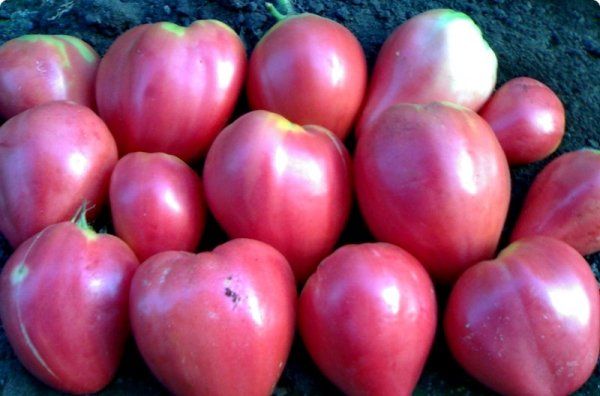The ox heart is a variety of tomatoes, which is easily recognized by the characteristic appearance of the fruit. In addition, it attracts a dense, "fleshy" pulp and excellent taste. In the article you can familiarize yourself with the description and characteristics of a tomato of this variety and make your choice in its favor when planting.
Table of contents
Description and characteristics of tomato
The ox heart is the result of the work of Russian breeders. This is a variety, not a hybrid. Differs large-fruited, high yield, disease resistance, medium and late ripening. Refers to indeterminantnyh varieties, that is, tall (up to 1.8-2 m), the growth of the stem of which lasts a long time.
Thanks to the last quality it is suitable for cultivation both in open ground and in greenhouse conditions. The plant has little leafy. Inflorescences with 4-5 fruits in each. The first is laid over the 8-9 sheet, the next - after 1-2 sheets. Most often formed in one, at least in two stalks.
The fruits of an ox-like heart of characteristic shape are round, tapering to the bottom, heart-shaped. Color from light pink to pink and crimson. As it grows, ribbing appears on the surface of the fetus. Despite this, ripe tomatoes tolerate transportation.
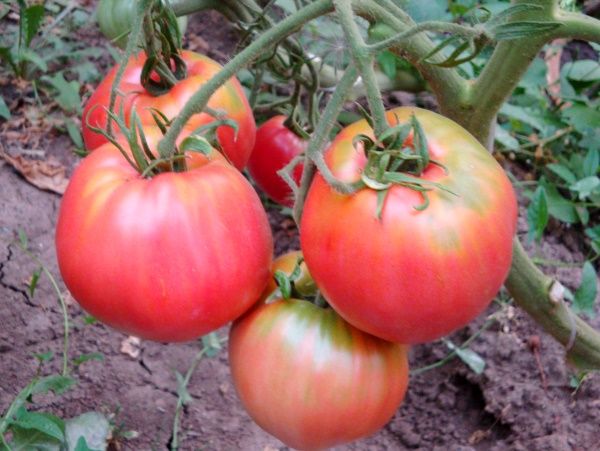
Fruits can grow up to 300-1000 g in weight.Because of their large size, they are not suitable for canning whole, therefore they are usually used for making salads and for fresh consumption.
The advantages and disadvantages of a cow heart
“The ox heart” fell in love with gardeners and farmers for such advantages:
- - high yield - up to 7 kg per 1 sq. M. m landing;
- - excellent presentation - heart-shaped at first sight attracts attention;
- - good taste - a fleshy structure with a pronounced tomato smell and a pleasant taste;
- - The possibility of growing in open and closed ground, including on an industrial scale.
The disadvantages of the variety include:
- - Long ripening period - more than 100 days;
- - the need for support and tying - a tall variety, in optimal conditions, capable of reaching 2 m in height;
- - poor keeping quality of fruits - ripe tomatoes are not stored for a long time.
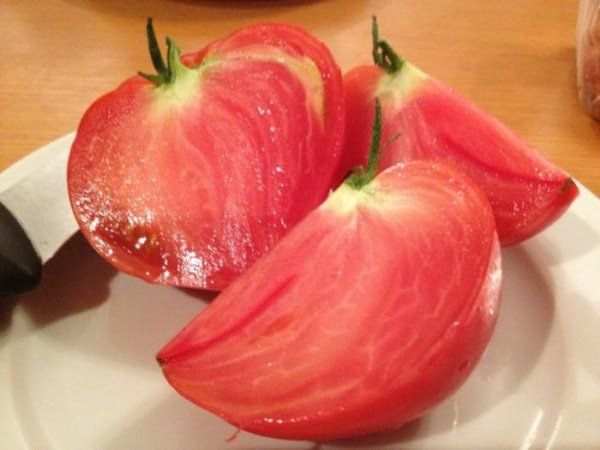
Tomato growing conditions
The variety Volove Heart was bred by breeders for cultivation in the open field in the southern regions of Russia. Nevertheless, it can grow in the middle lane and even in Siberia, if you provide greenhouse conditions.
Requirements for soil for planting
Tomatoes of this variety are preferably grown on light, fertile, well-aerated soil. There are no special requirements for the ground. The site should be chosen well lit and protected from the north wind.
Sowing rules
Since the “ox heart” has a long period of ripening, it is recommended to grow it with the help of seedlings. Exceptions are growing conditions in a warm climate.
Seedlings are sown in seedlings at the end of February - at the beginning of March. Before planting, they can be soaked for a day in a growth stimulator and treated with biofungicide. Seeds are placed on lightly compacted soil, sprinkled with peat and 1 cm of fertile soil. Moisturize with warm water and cover with film material. Leave until germination at a temperature of about 25 ° C.
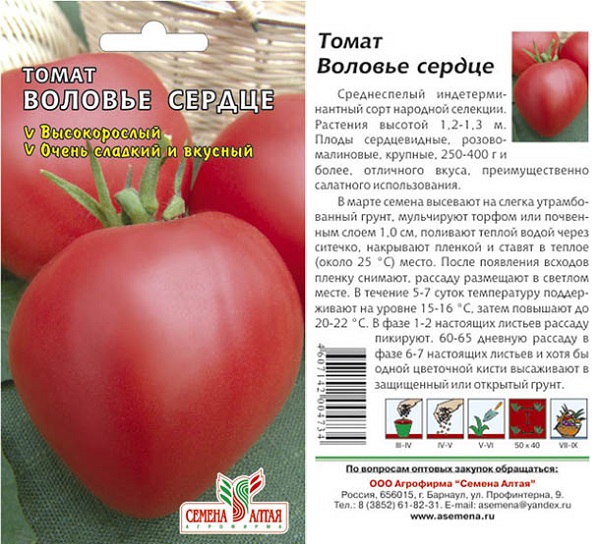
After sprouting sprouts, the film is removed and conditions are provided with a temperature of about 15-17 ° C and with abundant lighting (at least 14 hours a day). In the stage of 2-3 true leaves, seedlings are dived and transplanted in separate containers.In order not to need re-transplanting, containers should choose a volume of 0.5-1 liters.
You can feed 2-3 times with complex organic fertilizer in liquid form at the root. A week before transplanting into the ground, seedlings should be tempered — put them outside in good weather, starting from a few hours and gradually increasing their time on the air to a full day.
Transplanting seedlings in open ground
At the place of constant growth, seedlings of “ox heart” are transplanted in the phase of 6-8 true leaves. Young plants reach it at 60-65 day after planting. Depending on the sowing time, the transplant date falls in the middle - the end of May.
Planting scheme - 3-4 plants per 1 square. m. For convenience in the subsequent care, the distance between the rows should be 50-60 cm. Transplanted plants need to be poured abundantly and mulch. You can mulch with straw or any organic material, including non-woven. Thanks to this, in the future, you can significantly reduce watering.
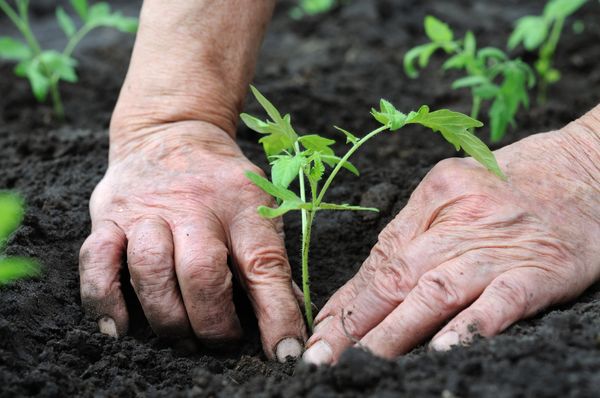
Grade care after transplanting
Having transplanted the seedlings to a permanent place, the subsequent care of it comes down to such operations:
- - watering;
- - pasynkovanie and the formation of the bush with simultaneous tying;
- - dressing;
- - removal of weeds;
- - loosening the soil;
- - if necessary - pest and disease control.
Watering - regular, warm, preferably settled water. Best under the root in the evening. Soil mulching will help maintain moisture longer, thereby reducing the number of waterings.
Since the plant is tall and under favorable conditions does not stop its growth, the bush needs to be formed and stading. For this you need:
- - Immediately after planting the seedlings to a permanent place, place a support with horizontal strings near it and tie up the main stem;
- — as you grow, remove the stepsons forming in the leaf axils and tie up the growing stem, paying special attention to the flower brushes so that the ripening fruits do not break it;
- - in the case of the formation of two stems as the second, leave the stepson above the first floral ovary.
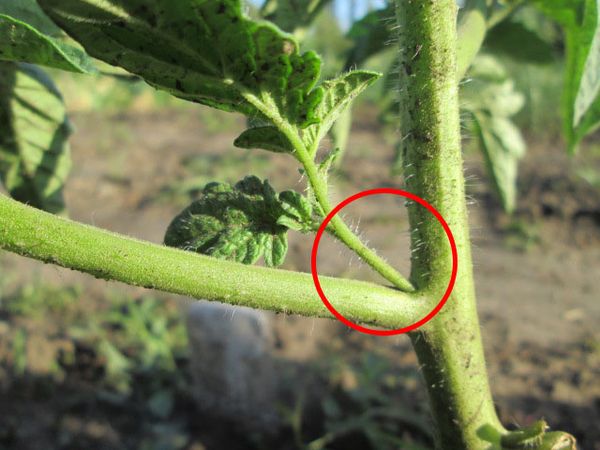
Top dressing - is carried out several times a season with fertilizers with a full NPK complex. At the same time it is recommended to feed:
- - 1-2 times with the addition of mineral fertilizers during the flowering period of the first brushes;
- - 1-2 times with the addition of nitrogen-potassium fertilizer during the formation and ripening of the first fruits;
- - 1 time - with the addition of phosphorus during flowering 5-6 brush;
- - further in the process of ripening of the main mass of fruits - a composition with a predominance of potassium (as necessary).
- Since tomatoes love the air in the soil, it is necessary to regularly loosen and weed between the rows, remove weeds, as well as sluggish and drying leaves. When grown in a greenhouse to improve pollination during the flowering period is to arrange drafts.
Diseases and their prevention
Cow's heart tomatoes, subject to agrotechnics and crop rotation, are resistant to diseases. However, this may be the case:
- - apical rot - often occurs due to drying out of the soil and lack of calcium;
- - late blight - occurs in conditions of high humidity, especially moisture on the leaves, thickening of plantings, abuse of nitrogen fertilizers and the addition of fresh manure.
- Late blight on tomato
- Tomato Rot Top Rot
As a preventive measure, the use of crop rotation, timely stading and weed removal, as well as the treatment of plants with phytofluorine are used.
The ox-heart is an interesting culture for both the backyard and industrial cultivation. Its fleshy fruits will surely appeal to lovers of fresh vegetables, and the gradual ripening will allow feasting on ripe tomatoes throughout the second half of summer.
